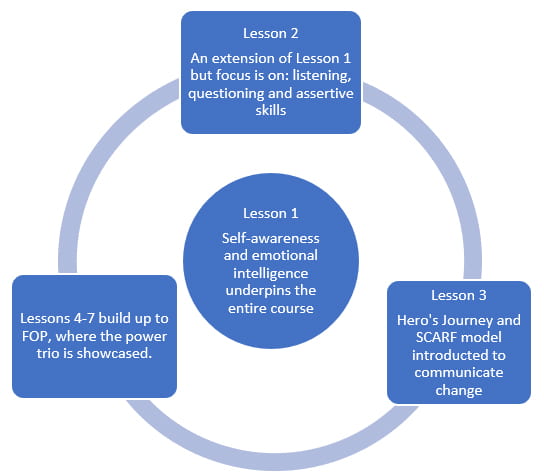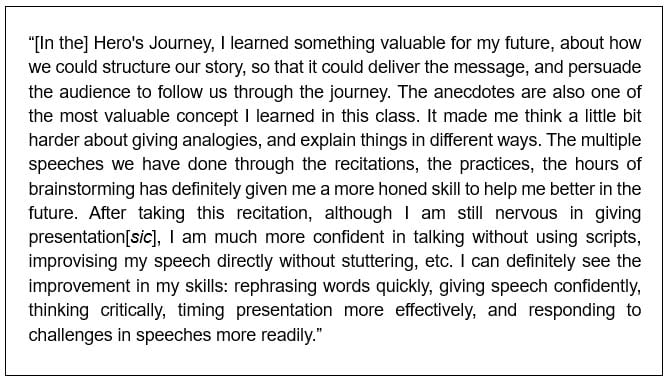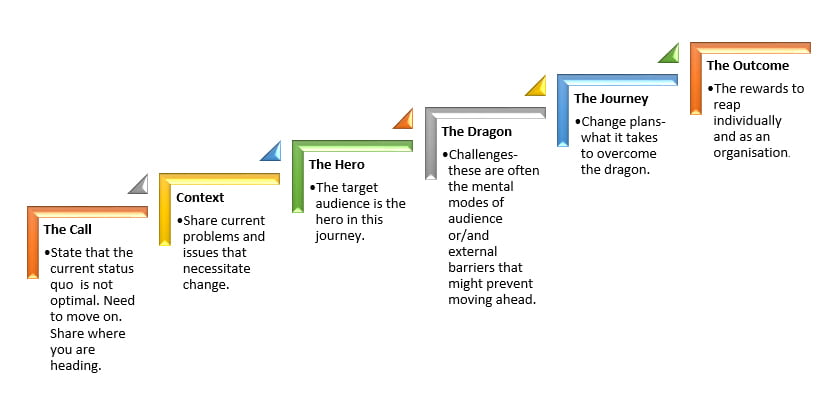Chitra SABAPATHY
Centre for English Language Communication (CELC)
Chitra chronicles the implementation of a “power trio” of approaches—learning about self-awareness, the trope of the Hero’s Journey, applying the SCARF model—to nurture the oral presentation (OP) skills among students enrolled in her communication course.

Image by Freepik
Sabapathy, C. (2023, August 28). The power trio: The role of self-awareness, the hero’s journey, and the SCARF model in nurturing students’ oral presentation skills. Teaching Connections. https://blog.nus.edu.sg/teachingconnections/2023/08/28/the-power-trio-the-role-of-self-awareness-the-heros-journey-and-the-scarf-model-in-nurturing-students-oral-presentation-skills/
This article chronicles and offers some reflection on the implementation of a structured and multi-disciplinary approach comprising cognitive, psychological, behavioural, relational, and affective elements, along with specific leadership communication skills to address the intricacies of nurturing oral presentation (OP) skills among undergraduates enrolled in an embedded course, IS31031 “Information Systems and Leadership Communication”.
Over the span of four semesters (AY 2021-2023), pre-course anonymous surveys consistently highlighted a common phenomenon among students: a significant sense of inertia, fear, and anxiety when it comes to OPs. It is important to acknowledge that OPs serve as the primary assessment mode in the communication component of IS3103. This apprehension towards public speaking is not exclusive to academia and warrants careful consideration, especially since previous studies confirm how OPs elicit intense struggles, fear, and anxiety (American Psychiatric Association, 2013; Aryadoust, 2015; Bartholomay & Houlihan, 2016; De Grez et al., 2012). These findings, combined with the results of the surveys conducted, emphasise the need to address these sentiments and explore innovative approaches to support students in overcoming their anxieties and achieving success in OPs. This attention is also critical now, in the context of the increasing influence of artificial intelligence (AI) on academia. Despite AI advancements, OPs offer alternate opportunities to evaluate students’ spoken skills, which are not easily replicable with AI assistance, at least not currently.
However, the OP as a form of assessment has been found to lack strong theoretical and pedagogical designs (Brown & Morrissey, 2004; Ginkel et al., 2015). This and the findings prompted the exploration of the “power trio”—a set of approaches comprising learning about self-awareness, the Hero’s Journey, and the SCARF model—to address the challenges2 of traditional approaches of teaching, learning and assessing3 OPs, and provide a comprehensive framework for enhancing students’ OP capacities in IS3103 (Figure 1).

Figure 1. Structure of lessons using the “power trio” approach.
Learning about Self-awareness
A significant design change of IS3103 has been incorporating a foundational lesson on self-awareness (see Appendix for excerpts of Lesson 1), which encourages students to reflect on their internal thoughts, emotions, and feelings and their influence on their communication and overall life experiences. Notably, nearly one-third of the students identified (through class reflections) learning about self-awareness as the most valuable aspect of the course.

The Hero’s Journey
The second strategy involves having to leverage on Campbell’s (1993) extensive study of various genres of stories, where he discovered a recurring narrative known as the Hero’s Journey (Figure 2). How is this relevant in IS3103? The course is centred on change communication and how students in their simulated roles (Ismail & Sabapathy, 2016) convince relevant stakeholders to implement change initiatives. The framework’s comprehensive, audience-centred, transformational story-based approach offers a valuable tool for change not just at the receiver’s end but also at the sender’s level (Williams, 2016). In a sense, the Hero’s transformational journey entails stepping out of one’s comfort zone, of necessitating a strong sense of self and of others, to navigate uncharted territory, acquire relevant skills and develop resilience, and make way for transformation into a stronger and more capable individual. The framework provides a “two-in-one” structure and narrative that helps individuals find significance and make sense of their experiences, even in challenging and chaotic circumstances.
Figure 2. The Hero’s Journey (click on the image for a full-sized version).
Several students, in their after-class reflections seem to predominantly reflect this value; here is one excerpt which represents this sentiment.

Applying the SCARF Model
The third “power trio” strategy is related to neuroscience and how distinct regions of the brain exhibit stimulation or limited activation under certain circumstances. The SCARF model (Rock, 2012), offers valuable insights into the social aspects of brain functioning, particularly in relation to status, certainty, autonomy, relatedness, and fairness (SCARF) and how these considerations provide a comprehensive understanding of how individuals respond and interact in various social situations (Figure 3). In change communication, demonstrating these aspects is a clear sign of the speaker having high emotional quotient levels and self-awareness.
 Figure 3. A list of responses of how individuals respond and interact in various social situations. Based on the responses, it can be observed that when the SCARF model is used effectively in communication, it reaps rewards and conversely when misapplied it triggers threats.
Figure 3. A list of responses of how individuals respond and interact in various social situations. Based on the responses, it can be observed that when the SCARF model is used effectively in communication, it reaps rewards and conversely when misapplied it triggers threats.

Having overseen the communication component of IS3103 since 2017, the ‘acid test of transference’ involves the extent to which students synthesise and demonstrate the “power trio” in their final oral presentations (FOPs). This FOP comprised multiple layers of complexity such as requiring different industry roles, diverse audiences, and implementing change as insiders within their chosen industries. Despite challenges, such as lack of time, as the communication component was offered for seven lessons (21 hours) and with large classes of about 20 students, improved self-esteem, communication skills, and positive impact were largely evident from tutor feedback, course reports, and unsolicited emails such as the one below.

In summary, I see value in how the “power trio” approaches have enabled students to enhance their OP skills. First, cultivating self-awareness serves as the cornerstone for students to develop a deeper understanding of themselves, effectively addressing their inhibitions surrounding OPs. Second, by employing the strategies provided by the Hero’s Journey and SCARF models, students gain the tools to compose and structure their presentations into captivating narratives that are both persuasive and audience-centred. In the process, students embark on a transformative journey where they not only learn about themselves but also develop a keen awareness of their audience’s needs and perspectives. This newfound proficiency empowers students to engage in impactful OPs.
I currently coordinate and teach the course CS2101 “Effective Communication for Computing Professionals”. Acknowledging the “power trio’s” value in improving students’ OP skills and to avoid duplication, I have introduced personalised frameworks emphasising self-awareness, relational pedagogy, and narratives. This approach reflects my ongoing commitment to enriching students’ communication abilities in unique and effective ways.
Endnotes
- Overview of the course. IS3103 was conceptualised by the School of Computing (SoC) and is offered as a compulsory embedded module with twin elements of content and communication to prepare its students for the working world. The communication component comprises seven three-hour face-to-face recitations that span across a semester and comes under the purview of CELC, while SoC colleagues teach the content component. The emphasis in the communication component is to equip students with leadership communication skills wherein interaction and delivering persuasive oral presentations are key.
- Challenges with traditional approaches of teaching and learning oral presentations (OPs). De Grez’s (2009) definition of OP competence highlights the combination of knowledge, skills, and attitudes needed to speak in public. This can also be understood as the inter-connectedness of the cognitive (knowledge comprising of content and structure, audience, assessment criteria), behavioural (presentation performance consisting of non-verbal elements), and affective (motivation, self-assessment, relevance) dimensions of teaching-learning (Bower et al., 2011; Bolívar-Cruz, & Verano-Tacoronte, 2018 ). Traditional approaches to teaching and learning OP skills often struggle to address these interconnected cognitive, behavioural, and affective dimensions of learning. The “power trio” approach integrates these dimensions by addressing the limitations of traditional methods and provides a comprehensive framework for enhancing students’ oral presentation skills.
- The “power trio” approach and assessment. The power trio approach has significantly reshaped the assessment of oral presentations (OPs) within the course. In this course, students are no longer measured solely on presentation skills, but also on the depth of their self-awareness. This involves their reflection on the presentation, their task interpretation, alignment with audience needs, self-awareness during delivery, and their incorporation of the Hero and SCARF models in their final oral presentations (FOPs).
Appendix. Excerpts of Lesson 1, on Self-Awareness
References
American Psychiatric Association. (2013). Diagnostic and statistical manual of mental disorders (5th Ed.). APA Press.
Aryadoust, V. (2015). Self- and peer assessments of oral presentations by first-year university students. Educational Assessment, 20(3), 199–225. https://doi.org/10.1080/10627197.2015.1061989
Bartholomay, E. M., & Houlihan, D. D. (2016). Public speaking anxiety scale: Preliminary psychometric data and scale validation. Personality and Individual Differences, 94, 211–15. https://doi.org/10.1016/j.paid.2016.01.026
Brown, T., & Morrissey, L. (2004). The effectiveness of verbal self-guidance as a transfer of training intervention: Its impact on presentation performance, self-efficacy and anxiety. Innovations in Education and Teaching International, 41(3), 255–71. https://doi.org/10.1080/14703290410001733302
Campbell J. (1993). The hero with a thousand faces (3rd Ed.). New World Library.
De Grez, L., M. Valcke, & Roozen. (2012). How effective are self-and peer assessment of oral presentation skills compared with teachers’ assessments? Active Learning in Higher Education 13(2), 129–42. https://doi.org/10.1177/1469787412441284
Ismail, N., & Sabapathy, C. (2016). Workplace simulation: an integrated approach to training university students in professional communication. Business and Professional Communication Quarterly. 79(4). https://doi.org/10.1177/2329490616660814.
Rock, D., & Cox, C. (2012). SCARF in 2012: Updating the social neuroscience of collaborating with others. NeuroLeadership journal, 4(4), 1-16. https://membership.neuroleadership.com/material/scarf-in-2012-updating-the-social-neuroscience-of-collaborating-with-others-vol-4/
Williams, C. (2016). A mudmap for living: A practical guide to daily living based on Joseph Campbell’s the Hero’s Journey. Retrieved from http://amudmapforliving.com.au/
Van Ginkel, S., Gulikers, J., Biemans, H., & Mulder, M. (2015). Towards a set of design principles for developing oral presentation competence: A synthesis of research in higher education. Educational Research Review, 14, 62-80. https://doi.org/10.1016/j.edurev.2015.02.002
 |
Chitra SABAPATHY is a Senior Lecturer with the Centre for English Language Communication (CELC), NUS. She has taught on both undergraduate and post-graduate programmes and developed courses related to Business, Technical and Professional communication skills. She has a longstanding interest in oral communication skills and is a strong proponent of collaborative, interactive, inclusive teaching, learning, and assessment methods. Her research interests are linked to inclusive higher education teaching and learning, widening participation, policy, and practice. Chitra previously contributed a post about the strategies her training team adopted to support valedictorians preparing to deliver their speeches for the virtual Commencement ceremonies held during the pandemic. Chitra can be contacted at elccs@nus.edu.sg. |


